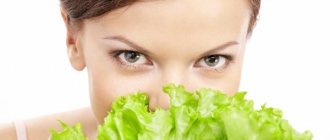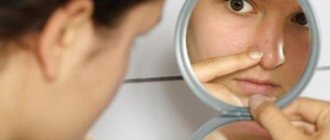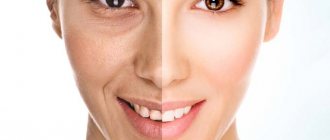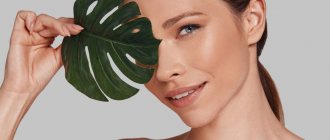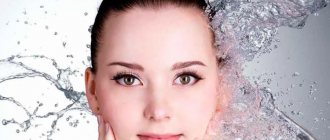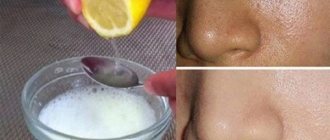Skin hydration is determined by adequate water intake and the prevention or reduction of transepidermal water loss (TEWL) in the stratum corneum (SC), which is provided by fats and natural moisturizing factor (NMF). The stratum corneum of the skin contains mature keratinocytes and consists on average of 15 layers of cells. Moisture in the skin is retained by amino acids and other osmolytes such as glycerin, lactic acid, taurine and urea.
Natural moisturizing factor is found only in the cells of the stratum corneum of the skin and consists of substances that can bind water. Maintaining proper levels of hydration is important for the normal functioning of various enzymes that function in humid environments.
Why does skin become dry?
The moisture exchange of the skin with the environment is determined by the amount of sebum secreted and the integrity of the epidermal layer, consisting of horny cells of the epidermis and fat.
It is responsible for protecting the integument from loss of fluid and penetration of foreign substances.
In the deep layers of the skin, water remains in a gel-like state. It is delivered to the dermis along with nutrients through the blood vessels. There is little liquid in the stratum corneum of the epidermis.
At this level, its active loss occurs, which is prevented by the epidermal layer and the hydrolipid mantle - the thinnest film on the surface of the integument made of fat, sweat and acids.
Dry skin can be due to internal or external causes
Endogenous factors leading to a lack of fluid in the deep layers and sebum deficiency:
- insufficient water consumption;
- vitamin deficiency;
- genetic features of the sebaceous glands;
- age-related decrease in sebum secretion;
- endocrine diseases;
- pathologies of the gastrointestinal tract;
- alcohol and cigarette abuse;
- dermatological ailments.
Exogenous factors that provoke damage to the epidermal defense and evaporation of moisture:
- climatic conditions - sun rays, frost, high temperature, wind, dry indoor air due to air conditioning and heating;
- exposure to chlorinated, salty or very hot water;
- the use of improper care products - alkaline soap, alcohol lotions, aggressive peelings.
Glycerin, petrolatum and hyaluronic acid are generally recognized hydrating substances. But if they are applied to the skin when the air humidity is less than 70%, they will draw water from deep layers to the surface, from where it can easily evaporate.
Harmful and Dangerous Moisturizing Ingredients
Along with these advanced approaches to treating skin dehydration, some cosmetic moisturizers may not be as effective and can sometimes be harmful to the skin.
- Mineral oil, as well as petrolatum, paraffin oil, and propylene glycol are advertised as moisturizers, but they create a dense film on the surface of the skin, interfering with respiratory and metabolic functions and disrupting its natural protective properties.
- Glycerin can be beneficial if the air humidity is above 65%, otherwise it draws water from all layers of the skin and can worsen dehydration.
- When applied externally, collagen will most often have a moisturizing effect due to the occlusive film, which may clog the pores. The molecules of this protein are too large to penetrate into the deep layers of the skin - where it is needed as the main structural unit. The exception is the molecules of marine collagen and modern technologies for its processing and delivery, which cheap Mass Market cosmetics cannot boast of, where the mention of collagen in the composition is a PR stunt in the hope that the consumer does not know about its penetrating ability.
- Lanolin, petroleum jelly and similar ingredients can be used short-term and for special dermatological indications. Modern cosmetology has abandoned their use, especially since the appearance of persistent hypersensitivity is considered a reaction to the use of lanolin.
About how to properly moisturize your skin at home and what herbal ingredients you can use. As well as the best ready-made recipes for tonics and masks, read the continuation of the material “Part 2: Deep hydration of facial skin at home - is it possible or not?”
Traditional bonus – Elena Malysheva’s point of view
The editors recommend:
What kind of hydration does your skin need?
Features of moisturizing oily skin
The main signs of oily skin are loose texture, enlarged pores, shiny shine, dull color and a tendency to inflammation. Most girls with such skin follow one path - they try to reduce the secretion of sebum using aggressive means, forgetting about moisturizing. As a result, the hydrolipid mantle is destroyed, and dehydration of the dermis occurs. And the sebaceous glands work even more actively, trying to compensate for losses.
Rules of care:
- Cleanse your face 2 times a day with gels and foams with salicylic acid, retinol and zinc. They have an antibacterial effect and reduce the activity of the sebaceous glands. Do not use products with high pH.
- After washing, wipe the skin with slightly acidic tonics with hyaluronic acid and AHA acids. They retain moisture in the cells. Alcohol lotions are contraindicated.
- 1-2 times a week you should use a soft facial peeling with tiny (non-sharp) abrasive particles to remove dead skin.
- In the morning and evening, apply a moisturizing gel (in summer) or a light cream (in winter) labeled “for oily skin.” They are made from water or essential oils - lavender, orange, rosemary, tea tree. It is important that the day cream has an ultraviolet filter of at least 15-20 units.
Moisturizing products for oily skin should be free of comedogenic (pore-clogging) components - mineral oils, paraffin, lanolin and others. It’s good if the cream or gel contains dimethicone - it absorbs excess sebum and mattifies the skin.
In a video about proper face washing from Malysheva
Hydration of dry skin
In youth, dry skin looks attractive, but with age, problems caused by a lack of moisture and nutrients make themselves felt - a feeling of tightness, peeling, irritation, and early wrinkles appear. Moisturizing such covers is a task of first necessity.
Rules of care:
- Wash your face twice a day with milk or a creamy product containing unsaturated fats, hydrogenated avocado, hazelnut, and sesame oils.
- Instead of tonics, use herbal infusions. Alcohol-free products with plant proteins, algae extract, and vitamins are also suitable.
- Carry out deep cleansing of the skin 2-3 times a month, using scrubs with soft abrasives. It is better not to use peelings with fruit acids and film masks.
- In the morning, lubricate your skin with moisturizer. It should contain substances to restore the lipid barrier - cholesterol, ceramides, urea, amino acids, minerals, polysaccharides, hyaluronic, linoleic, linolenic acids, sorbitol, milk proteins, antioxidants and so on.
- At night, apply a nourishing product with vegetable oils, fatty acids, ceramides, beeswax, whey proteins, vitamins E and A.
Winter hydration
Dry indoor air, frost and wind intensively destroy the skin's protective barrier. It should be restored with the help of preparations with oils and vitamins, and also do not forget about dry elbows and hands.
In cold weather, a nourishing cream should be applied to the skin in the morning, and a moisturizing cream should be applied before bed. It is better to carry out all procedures 1-2 hours before going outside.
A winter hydrating product should contain components that accumulate moisture in skin cells, these include:
- polysaccharides included in oat, cactus, and algae extracts;
- peptides that create the thinnest breathable film on the epidermis;
- antioxidants that fight free radicals - idebenone, tea extract (white or green), vitamin C;
- oils - avocado, shea butter, cocoa, coconut.
If you are severely dehydrated, you should undergo a mesotherapy procedure, which is an intradermal injection of a “cocktail” of vitamins, minerals, hyaluronic acid, collagen and plant extracts.
Reviews of non-injection facial mesotherapy.
Take homemade piggy bank in our article for DIY hand cream recipes.
Watch a video of how a cosmetologist does facial cleansing https://ilcosmetic.ru/uhod-za-litsom/chistka/litsa-u-kosmetologa.html
Article – comparison of Dysport and Botox here.
Facial gel Bark ENZYMATIVE GEL WITH PAPAIN FOR COLD STEAMING OF THE SKIN - reviews
The remedy is magical! Girls, if you have problem skin, and if you see this thing somewhere, take it, don’t spare the money! I found out about it by chance while surfing this site. I read the admiring reviews and realized that this was exactly what I had been missing for a long time. I can honestly say that I looked for it in my small town for a long time and tediously, I went to all the stores, all the pharmacies. KORA seems to be a popular company, available in many places. but the problem is that this particular gel is from a professional. new line series. for some reason, all the sellers were surprised when I was interested in this gel - GIRL, DID YOU NOT CONFUSE ANYTHING? WHERE DID YOU LEARN ABOUT IT? Finally, after getting tired of it, I decided to ask to order this product. and in a month I have it! It has a good composition - papain, clover, aloe juice. The main function of papain is to “pinch” the keratin protein and dissolve it. The cosmetic effect of this property is that papain removes dead cells, evens out skin texture, and stimulates the turnover of epidermal cells. The value of papain is that it is extremely gentle and is well tolerated by even the most sensitive skin. That is why enzyme peeling is considered the most modern, effective and at the same time gentle. Clover juice has an anti-inflammatory and antiseptic effect. Aloe juice has a healing and disinfecting effect on various wounds, burns, cuts and bites, as well as powerful anti-inflammatory, antiseptic, bactericidal, antibacterial and cleansing properties. This makes it possible to use aloe for the face with great success for such skin problems as acne and other pustular rashes, inflammatory processes. Therefore, the therapeutic effect of this enzymatic gel is immediately visible. I've only used it once so far, but it amazed me. Super! the skin is soft!!!! softer than that of my 2-year-old nephew) the skin is steamed and cleansed. but to get a deep cleaning, you need to try hard with your fingers, and all sorts of bugs come out at the slightest touch! I didn’t think that there was so much dirty stuff on my face... and what else struck me was that after cleaning my face was not inflamed, not wounded) only small bumps and slight irritation indicate that my face was touched many times. the next day I woke up and went straight to the mirror. the face is clean, without blackheads, without redness. my stages of use: 1. washed off makeup, cleaned my face with a scrub. 2. applied a little gel to the face, applied cling film, cut out holes for the nose and eyes) 3. after 25 minutes, washed off the gel. 4. cleaned from blackheads and comedones. 5. wiped the skin with alcohol. 6. I applied a mask made from brewed oatmeal and a bag of chamomile to my face. I washed it off after 10 minutes. I highly recommend it to everyone! Now I won’t see a cosmetologist for a long time) PS I want to buy a KORA anti-inflammatory soothing mask to soothe the skin after cleansing and consolidate the effect of the treatment. I read reviews about it and they praise it.
Home methods
Masks
Moisturizing masks help quickly saturate the skin with water, improve blood microcirculation and improve metabolic processes in cells.
For dry skin
- Combine 1 tablespoon each of cottage cheese, carrot juice, olive oil and warmed milk.
- Mix the egg yolk with 1 teaspoon of oat flour and 1 tablespoon of apricot kernel oil.
- Pour a tablespoon of flaxseeds for a face mask with water (200 ml) and boil until it becomes a porridge. Cool.
For oily skin
- Combine 50 g of white clay with water to obtain a paste, add 1-3 drops of tea tree ether and 1 large spoon of olive oil.
- Mix a handful of rolled oats with 50 g of natural yogurt.
- Grate ½ banana, add to it 1 teaspoon of kefir, honey and strong green tea.
For you, a DIY face cream recipe for dry skin.
Video recipe for a mask for dry skin from Everything Will Be Good
The masks are applied for 15 minutes, then washed off with warm water. After application, lie down and relax. The intensive course lasts 1-2 months and involves 2-3 procedures per week. Then you can do 1 mask every 7 days.
Oils
Vegetable oils are saturated with beneficial components that help restore the epidermal barrier and ensure a normal level of skin hydration.
The most pronounced moisturizing effect has:
- coconut oil – characterized by antioxidant and antimicrobial effects, does not clog pores;
- almond – protects from ultraviolet radiation, normalizes the functioning of the sebaceous glands, relieves irritation;
- jojoba – removes inflammation, disinfects, reduces sebum synthesis, tightens pores;
- Rosehip seeds – rich in vitamin C, evens out complexion and removes post-acne.
In addition, extracts from wheat germ, grape seeds, olives, sesame and others have regenerating and moisturizing properties.
Oils can be applied to the skin undiluted at night, added to moisturizer or masks.
Read reviews of paraffin baths for feet and hands.
Herbs
Linden, chamomile, calendula, parsley, chickweed, birch leaves, rosemary, yarrow, St. John's wort, strawberry leaves, mint, rose petals, elderflower flowers, coltsfoot and other plants are characterized by a moisturizing effect.
A decoction of them is prepared as follows:
- Take raw materials from one plant or a mixture of several equal parts.
- Pour cold water into an enamel pan. Proportion – 2 tablespoons of herb per 0.5 liters of water.
- Put on fire and boil for 5 minutes.
- Leave for 2 hours and filter.
The decoction can be used to rinse or wipe the face. Another option is to freeze in ice cube trays and massage into your skin for a few minutes.
You can make a mask from herbs:
- Combine 0.5 teaspoons of ground hop cones, chamomile, St. John's wort, yarrow and blackberry leaves.
- Pour a glass of boiling water over the raw material and leave for 20 minutes.
- Add 1 yolk, 1 teaspoon of honey and 1 tablespoon of apple juice to the unfiltered mixture.
- Lubricate your face and rinse after 15 minutes.
Watch a video tutorial on massage for facial rejuvenation at home.
For dry skin, herbal infusions can be prepared in milk.
Folk remedies
Aloe has the most pronounced moisturizing effect of all herbal remedies. Cucumbers, raspberries, apples, carrots, avocados, green tea, kelp, oats and plums are also characterized by hydrating properties.
Recipes:
- Tonic. Grind the aloe leaf and combine with 1 tablespoon of red wine. Wipe clean face with product applied to a cotton sponge. Wash after 20 minutes.
- Mask. Combine the pulp of ½ cucumber, 3 tablespoons of oatmeal (chopped) and 1 tablespoon of sour cream. Apply to face. Remove after 20 minutes.
Water
What water to use for washing to prevent dry skin? Liquid from the tap is not suitable for these purposes. Most often, it is saturated with minerals, salts and chlorine, which damage the epidermis.
Ways to solve the problem:
- install a filter that removes all harmful impurities;
- wash with bottled, artesian or mineral water;
- pre-freeze the liquid, then wait until it thaws;
- add a small amount of soda or milk to boiled water after cooling.
Temperature is no less important. Cold water sharply constricts blood vessels, and hot water damages the lipid mantle. The best option is a temperature of about 35ºС.
The easiest way to moisturize your skin at home, see
Look at the photos before and after facial bioreinforcement.
For oily skin, after the main wash, you should rinse your face with cool water to tone the skin and tighten the pores.
Hydration from the inside
It is not possible to achieve skin hydration using external products alone. It is important to nourish it from the inside.
Basic recommendations:
- drink 1.5-2 liters of purified water per day, in hot weather the amount can be increased;
- eat moisture-rich vegetables and fruits - radishes, celery, pumpkin, watermelon, grapes, cherries, raspberries, melon, tomatoes;
- include in the diet foods that help retain water in the dermis and restore the lipid barrier - mushrooms, seaweed, greens, citrus fruits, red fish, nuts, legumes, unrefined cereals, eggs, liver and others.
Fast way
Basic methods for fast skin hydration
- Moisturizing stick. It is a compact product that resembles lipstick. It contains active components - collagen, oils. The stick should be used to wipe certain areas of the face that are prone to dryness. Not worth using constantly.
- Spray with thermal water from natural underground springs. The peculiarity of the liquid is its high content of mineral salts. It provides osmotic hydration of the surface layers and restoration of water balance. But if there is not enough fluid in the deep cells, then hydration will be short-lived. Thermal water is convenient to use for refreshment in the summer heat, as well as in air-conditioned rooms.
- Intensive fabric masks or creamy products in tubes. They contain oils and vitamins that instantly nourish the skin, providing it with hydration.
Reviews
Nika. A favorite recipe for moisturizing the skin is to pick an aloe leaf, grind it in a blender, apply to the face for 15 minutes, rinse and apply a light cream. Zhenya. In the summer, I periodically make a cucumber mask - cut it into circles and apply for 5 minutes. I don't wash my face. The skin becomes soft.
Faith. I prefer ready-made masks. My favorites are Vishy, Estee Lauder, Avene.
Lana. Once I tried to lubricate my face with aloe pulp - an allergy began. To moisturize the skin, I use a mixture of oatmeal and kefir, and I also like a mask of strawberries and sour cream.
Keeping your skin hydrated is an important task for every woman. When there is a lack of fluid in the dermis, the physiological processes responsible for the absorption of nutrients and cellular respiration slow down. As a result, tissue trophism deteriorates, the elasticity of the integument decreases, they become dull and covered with wrinkles. To maintain water balance, it is necessary to regularly apply moisturizer to the skin, use folk remedies or ready-made masks, as well as eat a balanced diet and drink plenty of fluids.
